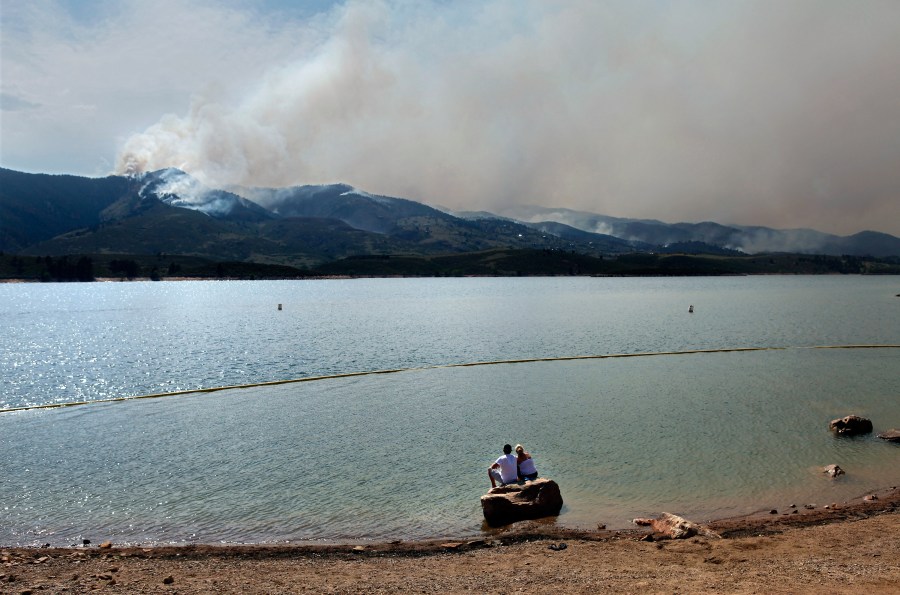Livestreaming video can help 911 dispatchers aid callers

FILE – In this March 15, 2018 file photo a dispatcher works at a desk station with a variety of screens used by those who take 911 emergency calls in Roswell, Ga. On Friday, Dec. 7, 2018, The Associated Press has found that stories circulating on the internet that dispatchers are trained to interpret a takeout pizza order as a covert way of seeking emergency assistance, are untrue. (AP Photo/Lisa Marie Pane, File)
(NewsNation) — In broad daylight, an elderly Connecticut couple were faced with a frightening encounter: strangers at their door, seemingly trying to bang it down.
“There was people banging on somebody’s door — like just going crazy banging on these people’s door,” said Sgt. Matthew Cassiere of the New London, Connecticut, Police Department.
When they called 911, something new happened. Their phone prompted them to set up a video stream of the people at the door.
“As a result of that, because we were able to get that … video of them, of the people that were doing this, we were able to clearly identify who they were within minutes,” he said.
With the help of the video, police were able to apprehend the suspects.
In New London, police use software provided by a company called Prepared, which has helped police respond to emergencies with more information in hand. Cassiere said they’d used the platform 65 times since they started using it late last year (though some of those uses were in training).
The software only works with callers who are calling from camera-equipped smart devices — landlines aren’t compatible. But Prepared CEO Michael Chime pointed to statistics showing that most 911 calls are now from mobile devices.
“There’s 250 million 911 calls that go through our systems every year — and if you think about it, if 80 to 90% of them are leaving life-saving data on the table, that’s a really important problem to go out and solve,” Chime said.
Prepared currently has customers in 45 states; Chime said the dispatcher centers they’ve signed up across the country cover approximately 13% of the U.S. population. There are also other companies who are offering similar services.
Some of these centers, like the one in New London, are using the free version of the software that provides video access to dispatchers when callers click on a link that’s sent to them. There’s also a paid version.
“Where we charge … is for the responders. So, if police, fire, EMT want to see those videos in real-time before they get there, we charge a per-user, per-month to do it,” Chime said.
The Larimer County Sheriff’s Office in Northern Colorado started using the paid version last year. The area’s topography makes it an ideal candidate for the software, according to Public Information Officer Kate Kimble.
She said the mountainous areas of the county and the popularity of outdoor activities can put visitors in need of their assistance.
“Beyond just the hikers getting lost, there’s always potential for helping illuminate what’s going on around maybe a criminal activity, but also that kind of fire environment … it’s just really a great tool for our region to give first responders in a number of different categories,” Kimble said.

In one case, a witness reported a structure fire using a livestream that first went to the dispatcher, and later to the first responders.
“They were able to stream video from the area so firefighters knew kind of the scope of the fire, how they were going to attack it safely and quickly to avoid it spreading or causing more property damage,” Kimble said.
The system relies on cooperation from callers, who have several opportunities to deny access.
“It’s not just one opt-out, they have multiple opt-outs. They don’t have to click on the link, they don’t have to click the button, they don’t have to hit ‘Allow,'” Chime said. “There’s really three points where they can say no, and we have people fall off on every one of those points, and we’re A-OK with that.”
Cassiere said that in 70% of the cases where they used the platform with a caller, they were able to form a connection with a citizen. The citizen either shared a video, photo, texted or shared their location.
There is a cost barrier for some departments, which may already be dealing with staffing shortages and aging equipment. In New London, emergency workers got access to the service in 2022, but because of complicated logistics, the department stuck with the free version.
“We are in the middle of a couple of other big projects, so bringing on another project right now is not ideal,” Cassiere said.
When asked what advice he’d give to other departments, Cassiere encouraged them to try the software.
“I would say get a trial and just do it,” he said. “Because it’s one of those things where there’s no con to it. At least the version we’re on is free, the benefit is immediate. The setup is very simple. So, it’s honestly a no-brainer.”










